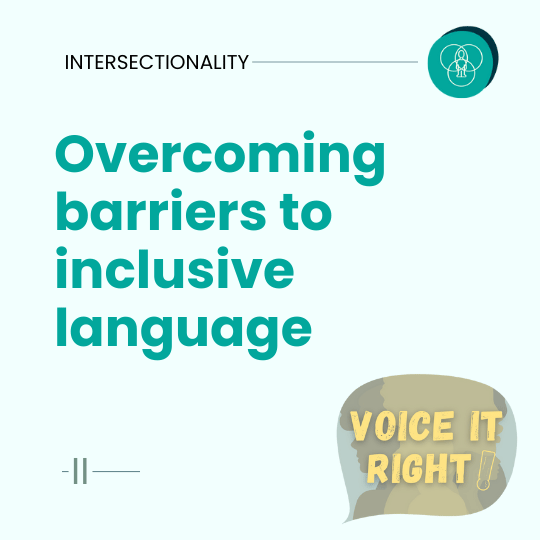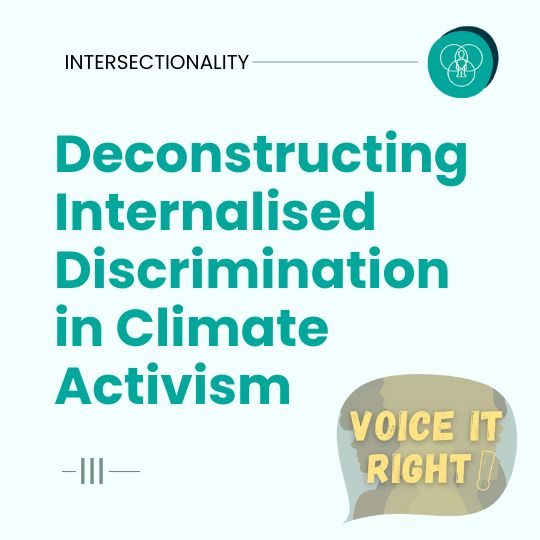
Share this article
Written by

Sara Chehade
Contents
Follow the #VoiceItRight campaign on
Language is more than just a means of communication; it’s the lens through which we view the world, shape our thoughts, and engage with each other. In the realm of climate activism, language serves as a powerful tool that can either unite or divide, empower or marginalise.
Imagine language as the thread that weaves the fabric of our collective consciousness. The words we choose can spark action, inspire hope, and bring about change. But they can also perpetuate stereotypes, alienate those who are already vulnerable, and reinforce existing power dynamics. This dual nature of language makes it a critical component in any social campaign, particularly one aimed at addressing the complexities of climate change.
Why do we need an inclusive language when talking about climate change?
When we talk about climate change, the language used often frames the issue in ways that are too technical, abstract, or detached from the lived realities of those most affected. Terms like “carbon footprint,” “mitigation,” and “adaptation” may resonate in policy circles, but they can feel distant or inaccessible to young people and marginalised communities. This disconnect is not just a barrier to understanding; it’s a barrier to action.
On the flip side, inclusive language invites participation and fosters a sense of ownership. For instance, using stories and experiences from marginalised communities can bring the abstract concept of climate change into sharp focus, making it relatable and urgent. Instead of merely talking about rising sea levels, we might share the story of a coastal community in the Global South that is losing its homes and heritage. Such narratives are not just informative; they are transformative.
The importance of language also extends to how we frame solutions. Eurocentric narratives often dominate the discourse, sidelining indigenous knowledge and local practices that have sustainably managed environments for centuries. By broadening our linguistic horizons and embracing diverse perspectives, we enrich the global conversation on climate action and ensure that solutions are culturally relevant and inclusive.
In youth work, the stakes are even higher. Young people are not just the leaders of tomorrow; they are the change-makers of today. The language we use with them can either empower them to take charge of their future or discourage them by making them feel excluded or unheard. Consider the difference between saying, “You are the future” versus “Your voice matters today.” The former, while well-meaning, places the burden of change on an undefined future, while the latter empowers youth to act now.
Language, Intersectionality, and Marginalised Youth
Intersectionality, a term coined by scholar Kimberlé Crenshaw, refers to the way different forms of discrimination—such as racism, sexism, and classism—intersect and create unique experiences of oppression for individuals, particularly those from marginalised groups.
The role of intersectional language in climate activism
In the context of climate activism, language plays a pivotal role in either highlighting or obscuring these intersecting identities and the challenges they face.
For marginalised youth, especially those from communities of colour, low-income backgrounds, or non-Western cultures, the impact of climate change is not just an environmental issue but a deeply personal one that intersects with issues of social justice, economic inequality, and historical oppression. The language used in climate discourse often fails to capture these complexities, instead presenting a one-size-fits-all narrative that overlooks the nuanced realities of these young people.
When climate activism ignores intersectionality, it risks alienating the very groups that are most affected by climate change. For example, discussions that focus solely on carbon emissions without considering how environmental degradation disproportionately impacts low-income communities can render the concerns of these groups invisible. Similarly, climate campaigns that centre Western perspectives may inadvertently marginalise indigenous knowledge systems and the voices of youth from the Global South.
Language that acknowledges intersectionality, on the other hand, can empower marginalised youth by validating their experiences and recognising the unique challenges they face. It opens up space for their voices to be heard, not just as victims of climate change, but as leaders in the movement for environmental justice. For instance, instead of framing climate action as a universal issue with a single solution, language that emphasises intersectionality would highlight the diverse strategies needed to address the different ways in which climate change affects various communities.
Moreover, inclusive language in climate activism can help build bridges between different social movements, fostering solidarity across issues of race, gender, and class. By recognising that the fight against climate change is also a fight against systemic inequality, activists can create more holistic and effective strategies that resonate with a broader range of youth.
For marginalised youth, whose identities are often shaped by multiple layers of discrimination, language that reflects intersectionality can be a powerful tool of empowerment. It can validate their experiences, amplify their voices, and place them at the centre of climate action, where they belong. In doing so, it not only strengthens the climate movement but also ensures that the solutions we create are just, inclusive, and sustainable.
More articles from the #VoiceItRight campaign
Our mission
 YEE aims to unite environmental youth non-profit organisations in Europe in order to enhance international cooperation, increase knowledge about the climate crisis, raise awareness of environmental problems and to strengthen participation of youth in environmental decision-making.
YEE aims to unite environmental youth non-profit organisations in Europe in order to enhance international cooperation, increase knowledge about the climate crisis, raise awareness of environmental problems and to strengthen participation of youth in environmental decision-making.
Get in touch
Vinohradská 2165/48
120 00 Praha 2 – Vinohrady
Czech Republic
E-mail: yee@yeenet.eu


Financially supported by the European Youth Foundation of the Council of Europe. The views expressed do not necessarily reflect the official position of the Council of Europe






